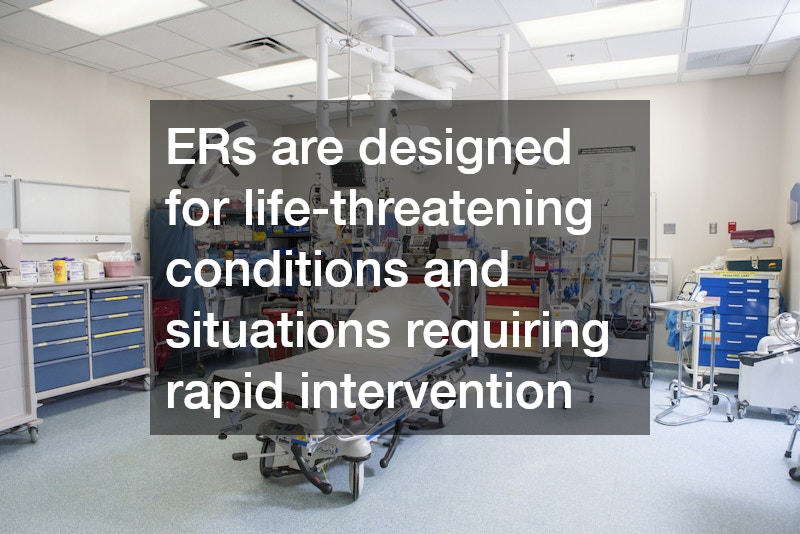
One of the most crucial decisions in a medical situation is knowing when to visit the local emergency room. It is important to recognize the difference between urgent care needs and those that necessitate the immediate attention of an ER. Symptoms like severe chest pain, difficulty breathing, or significant trauma typically demand emergency attention.
Many injuries or illnesses can be treated at urgent care facilities, potentially saving time and resources. Always remember that true emergencies require swift action where every second counts.
ERs are designed for life-threatening conditions and situations requiring rapid intervention. It’s about prioritizing the severity and urgency of the medical need. Non-emergency cases at an ER can lead to overcrowding, which might delay care for true emergencies. If uncertain about the intensity of the condition, contacting a medical professional for advice is a prudent step. Remember, consulting a healthcare professional, even from home, can be a wise preventive measure.
Educational resources are available that can help you decide when to head to the local emergency room versus visiting an urgent care center. Many health systems provide guidelines or hotlines where advice can be sought. Families should discuss and prepare for emergency scenarios in advance, equipping everyone with knowledge on assessing circumstances. Additionally, individuals with chronic conditions should have an clear plan detailing when an ER visit becomes necessary. These proactive steps help alleviate stress and ensure quicker response in times of crisis.
What to Expect Upon Arrival
Upon arrival at the local emergency room, expect to go through a triage process. Triage is a system of prioritizing patients based on the severity of their condition. A nurse or medical professional will assess your symptoms to determine how quickly you need care. This ensures that those with life-threatening conditions receive immediate attention. While it might seem unfair at times, understand that this system is in place to save the most lives.
Registration will follow, where basic personal and insurance information is collected. Providing accurate and complete information can speed up the process considerably. It’s beneficial to bring identification and insurance cards to avoid delays. This information helps the hospital to document the visit, facilitate treatment, and verify coverage details. Staying calm and cooperating with the staff is essential for a smoother admission process.
The waiting time in an emergency room can vary significantly. Factors influencing wait time include the number of patients and the severity of cases. In some scenarios, those who arrived later with more severe issues might be seen before you. It’s beneficial to bring a book or a device to keep occupied as you wait. Patience is key as the medical team prioritizes life-saving treatments.
Preparing for an ER Visit
Preparation for a potential emergency room visit can minimize stress and escalation of any situation. Keeping a list of medications, allergies, and medical history readily available can expedite treatment. In emergencies, quick access to such details ensures accurate and fast-moving care. It’s also wise to know the location of the nearest local emergency room and have directions easily accessible. Being organized can alleviate confusion and speed up the time to receive help.
Having an emergency contact is crucial in these situations. Informating your emergency contact of any pertinent medical information can facilitate communication with medical staff. Decide who will be responsible for you in the event you can’t speak for yourself. Share your medical directives with this person, as well as any other important documents. Mutual readiness can be life-saving in critical scenarios.
In addition to preparation, understanding the ER billing process is vital. Emergency care can be expensive, and not all services may be covered by insurance. Verifying what your policy includes in terms of emergency care is a smart step before any potential trip to the ER. Knowing this information enables you to manage financial surprises later on. Clear and proactive communication with insurance providers can prevent post-care financial stress.
The Role of ER Personnel
The emergency room is staffed with various specialists, all playing vital roles in patient care. Emergency physicians are trained to handle acute illnesses or injuries with expertise. They’re supported by nurses, radiologists, and laboratory technicians who ensure timely patient assessments. This team acts swiftly in emergency situations to provide critical interventions. Their collaboration is essential, resulting in coordinated care to optimize patient outcomes.
ER nurses are at the forefront, providing patients with direct care during sometimes long waits. They perform crucial assessments and carry out physician orders efficiently. Their ability to manage high-pressure situations showcases the critical skills inherent in emergency care environments. Communication between the medical team and the patient is a priority, ensuring clarity and confidence in care received. Respect and patience towards ER staff can facilitate a more positive experience during stressful moments.
Hospitals employ dedicated professionals who focus on patient advocacy and care coordination. These experts work behind the scenes to ensure seamless patient journeys. They assist with the complexities of healthcare systems including paperwork and post-care arrangements. Their involvement reduces miscommunications and streamlines processes between departments. Patient outcomes benefit immensely from the integrative efforts of these important individuals in the ER ecosystem.




